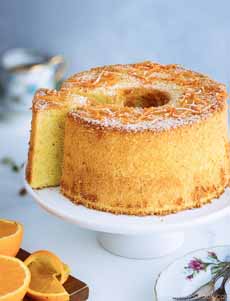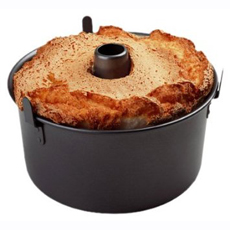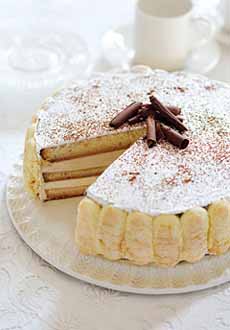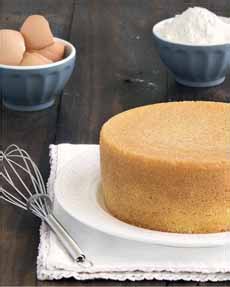|
Sponge cake is a light and airy cake with no fat, traditional flour or leavening. The rise comes from beating air into egg whites.
Here’s the history of sponge cake.
The Jewish-style sponge cake—a Passover mainstay because it has no leavening—is not the same as génoise.
Génoise, the French sponge cake made with conventional flour and butter.
Passover sponge cake substitutes potato starch and matzoh meal for conventional flour, and contains no fat.
Sponge cake is a delight year-round, but is not the only type of sponge cake.
Check out the following, and plan ahead for National Sponge Cake Day, August 23rd.
PARTY IDEA: Get your friends-who-bake together and have a tasting of all of these for National Sponge Cake Day.
THE DIFFERENT TYPES OF SPONGE CAKE
Chiffon cake (photo #1), an American invention, is a hybrid of sponge and génoise. It uses a leavening agent and oil, which makes the cake moist than a sponge. The yolks and oil are beaten with the dry ingredients; the whites are whipped separately and folded in. Here’s the history of chiffon cake.
Genoese or Genovese or Italian sponge cake is the original sponge cake, made without leavening but with conventional flour and fat. It was invented in the Italian city of Genoa (one story says it was made in Spain, by the Genoese ambassador to Spain [i.e., his cook]). It is often confused with pan di spagna, but the two are different (see below).
Génoise, the French sponge (photo #2), has added fat. Clarified butter enriches the batter and makes the cake moister. The eggs are beaten whole, sometimes with additional yolks. Génoise is used in layer cakes and roulades (rolled cakes), among others.
Jewish-style sponge cake or Passover sponge cake (photo #3) was adapted by Italian Jews for Passover (so were Italian amaretti—here’s an [amaretti recipe]), because it contains no leavening. It then spread through other European Jewish communities. It has no added fat, and the yolks and whites are beaten separately. It is typically baked in a tube pan.
Ladyfingers or sponge fingers or savoiardi, finger-shaped sponge cookies that originated in late 15th century Italy at the court of the Duchy of Savoy (photo #4). Here’s more about them. They are a form of Italian sponge.
Pan di Spagna (“Spanish bread”—photo #5) is another type of Italian sponge cake. While genoese is made by cooking the eggs and sugar together, whisking them over a bain marie and then adding some melted butter, pan di spagna is made without heat. With pan di Spagna, the eggs are whisked separately. The lightness is achieved by whipping the whites into stiff peaks, and there is no added fat. This technique is the same as with Jewish-style sponge cake, except that pan di spagna uses traditional flour.
Other sponge cakes include castella (Japanese sponge, very fine crumb), Lamington sponge (from Australia, a jam-filled sponge sandwich dipped in chocolate and covered in coconut), Victoria sponge/Victoria sandwich (U.K.—photo #6) and zuppa inglese (Italian).
RECIPE: PASSOVER/JEWISH SPONGE CAKE
This recipe is from our mom. Although she is no longer here to bake it, she would be pleased if you did.
Ingredients
12 medium or small eggs, carefully separated
1 cup sugar
Juice and zest from 1 lemon
1/2 cup orange juice
1/2 cup potato starch
1/2 cup matzo meal
Pinch salt
Preparation
1. PREHEAT the oven to 325°F. Separate the egg yolks from the whites, being sure not to get a single drop of yolk mixed into the whites (otherwise the cake will not rise properly).
2. BEAT the yolks; then add the sugar, lemon and orange juices.
3. SIFT the matzoh meal and potato starch together, then add to the yolks. Using a clean bowl and beaters with no trace of the other ingredients…
4. BEAT the egg whites with a dash of salt in a large bowl, until they are fluffy and stiff (the peaks should separate from the sides of the bowl). Fold in the yolk mixture a bit at a time. Pour into an un-greased tube pan (photo #3) and bake for 50 minutes.
5. TURN the pan upside down to cool. Be sure the top of the cake does not touch the surface, or it will mash in.
WHAT TO SERVE WITH SPONGE CAKE
Mom served this cake as a strawberry shortcake, with whipped cream, berries and the sponge instead of biscuits.
This cake is so versatile that you can serve plain, fancy or in-between.
Mix and match as you like:
Berries or other fruit (sliced stone fruit in the summer)
Citrus glaze and julienned peel (lemon, lime, orange—add some liqueur if you like)
Fruit curd
Fruit sauce
Ice cream (try vanilla, strawberry or other fruit flavor)
Ice cream sundae (sponge cake, ice cream, chocolate or butterscotch sauce)
Whipped cream
Garnishes: chocolate curls, nuts
>>>CHECK OUT OTHER CAKES IN OUR CAKE GLOSSARY<<<
|
|

[1] Chiffon cake is a hybrid of sponge and génoise. Here’s the recipe for this beautiful Orange Chiffon Cake from Just One Cookbook.

[2] Fraisier, a “strawberry shortcake” made with genoise (photo courtesy G Bakes).

[3] Jewish-style sponge cake (photo courtesy Chicago Metallic Bakeware).

[4] In addition to other uses, ladyfingers are an ingredient in tiramisu (photo of tiramisu cake courtesy Mackenzie Ltd).

[5] Pan di spagna. The name is often used synonymously with a genoese sponge, but there is a difference (see bullet point). Here’s the recipe from Easy As Apple Pie.

[6] A Victoria sponge or sandwich comprises two sponge layers filled with jam and buttercream, popular at tea time (photo Primo.co.uk).
|





